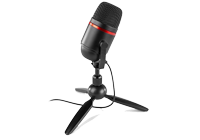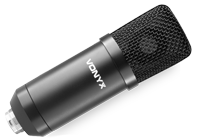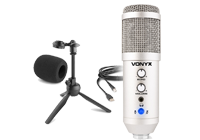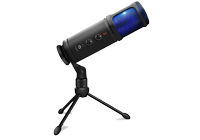Unlike dynamic microphones, studio microphones require extra voltage to operate known as phantom power. These microphones also use a different pickup design in the form of a condenser which provides a much broader frequency range and capture pattern. Studio microphones are perfect for recording vocals, online radio shows and podcasts.
Many of our studio mics come with stands in a desktop mount or boom-arm style. The desktop mounted stands are in a tripod style and have a compact design, while the boom arm stands are much larger and clamp to the edge of a desk. Both being great solutions in a studio setting, our studio microphone kits are perfect for singing, speech and in some cases, instruments.
The majority of our studio microphones include a pop shield or pop filter. These act as a barrier to reduce harsh bursts of air hitting the microphone that cause poor audio recordings. A pop shield is a thin, usually circular, add-on that clips to the microphone stand and a pop filter is a foam add-on that covers the microphone itself. Both are great to reduce harsh sounds produced by your voice and are ideal in studio settings.
Which is the best studio microphone?
There are many different types of studio microphones available, and each serves its purpose for different reasons. For example, we offer many studio microphones that are tailored for speech purposes in podcasting scenarios, while we also offer studio mics that can withstand harsher sounds which are more ideal for singing purposes.
Something that should be taken into account when choosing a studio microphone is the space you have available and how you intend to use it. If you have limited space available and you will be needing to relocate the microphone frequently, it would be best to go for one that includes a desktop tripod stand. If you want a more permanent solution and you have the space available, a studio mic with a boom-arm stand may work best for you.
Another thing to consider when choosing a studio microphone is the other equipment you already have that you intend to use it with. If you have a mixing desk with phantom power, a microphone with a standard XLR connection would work best. For a minimalistic setup where you don't have much other equipment, a USB microphone would be ideal as it can connect directly to a laptop or PC without the need for a mixing desk.
Depending on the way you want to use the microphone, it is useful to look for the included features. For example, if you are after a microphone for podcasting or live streaming, it would be ideal to have a mute button for moments where you don't want your voice to be broadcasted.
How do studio microphones work?
Without getting too in-depth, studio microphones convert acoustic energy (your voice) into a digital electrical signal that can then be amplified and recorded. All of our studio microphones have a condenser design, which in essence, means that there are two metal plates inside the casing that are in close proximity to each other with a low voltage between them. They vibrate when sound waves hit them, causing an electrical signal to be produced which can then be amplified.
To actually hear the digitised signal, it will need to be amplified where you can then hear it through speakers or headphones. Our range of studio microphones with just an XLR connection will need to be connected to a mixing desk with phantom power built-in, as the condenser design requires additional voltage. USB microphones connect straight to a PC and the built-in battery provides the extra required voltage, perfect for small studio setups.
The polar pattern of a studio microphone tells you the directions that it can reproduce sound from. The most common polar pattern is cardioid, which reproduces sounds from the front and sides of the mic while eliminating sound from the back. In a small studio setting this is perfect, as you would commonly have speakers facing towards you.
Several of our studio mics feature adjustable volume or gain control which adjusts the input signal of the microphone. This is great if you are using the microphone for multiple purposes, such as speech recording and instrument recording. When recording lower volume sounds, the gain can be safely turned up so that the microphone can more easily reproduce the sound. If you are recording higher volume sounds such as high-pitched singing, the gain control should be turned down so that the signal doesn't distort.
Buy studio mics
We have a wide range of studio microphones to offer, each of which are great for their own purposes. The microphone you choose will depend entirely on the way you intend to use it and what you want it to achieve.
If you aren't entirely sure which microphone would be the best one for you, please do not hesitate to contact us and we will be happy to guide you through your options and which one would suit you best.
Frequently Asked Questions
What is the best mic for studio?
There is no one "best" microphone for studio use, as the ideal microphone choice depends on the specific recording needs and preferences of the user. For example, if you are wanting to record a drum kit, you will need a microphone that can handle loud noises efficiently. On the other hand, if you want a studio microphone for speech only, you would need a microphone that is able to pick up even the most intricate noises.
Should I get a dynamic or condenser mic for studio?
When deciding between a dynamic or condenser microphone for studio use, it's important to consider your specific recording needs and preferences. Dynamic microphones are known for being more durable and less sensitive to background noise than condenser microphones. They can handle high sound pressure levels, making them a good choice for recording loud instruments such as drums or guitar amps.
On the other hand, condenser microphones are more sensitive and capture more detail than dynamic microphones. They tend to have a flatter frequency response and a more natural sound, making them ideal for recording vocals or acoustic instruments.
How do I connect a microphone to my computer?
To connect a microphone to your computer, you will need to identify the type of connector used by your microphone. Most microphones use either an XLR or 1/4-inch connector, while others may use a USB connector.
If your microphone uses an XLR or 1/4-inch jack connector, you will need an audio interface to connect it to your computer. An audio interface is a device that converts the analog signal from your microphone into a digital signal that can be processed by your computer.
If your microphone has a USB connector, you can plug it directly into your computer's USB port. Once connected, your computer should recognize the microphone and automatically install any necessary drivers.
What type of microphone should I use for recording instruments?
When it comes to recording instruments, the type of microphone you should use depends on the instrument you are recording and the sound you are trying to capture. For example, you may need a condenser microphone if you are recording electric guitar amplifiers, as they are capable of handling louder volume levels. On the other hand, you may need a shotgun-style microphone to record a grand piano, as it can capture the full sound of the piano at a distance for a warm and clear recording.
Can I use a studio microphone for live performances?
It is not generally recommended to use studio microphones for live performances. Studio microphones are typically designed for use in controlled environments with minimal background noise, so they may not be as durable or resistant to feedback as microphones designed specifically for live performance.
What to look for when buying a studio microphone?
When buying a studio microphone, you should look at the type of microphone and whether or not it will be suitable for your intended recording purpose. For example, if you want a microphone that connects directly to your PC for podcasting, a standard USB condenser microphone will be suitable. On the other hand, if you want to record loud instruments in a studio setting, it would be better to go for a mic with a large diaphragm that can handle loud noises.
Which mic is best for removing background noise?
No microphone can completely eliminate background noise, but some types of microphones are better at rejecting unwanted sounds than others. Directional or cardioid microphones are typically better at rejecting background noise because they are designed to pick up sound from a specific direction, rather than from all directions.
What type of microphone should I use for vocals?
When it comes to choosing a microphone for vocals, there are two main types to consider: dynamic and condenser.
Dynamic microphones are typically more rugged and can handle high sound pressure levels, making them a good choice for live performances. They are also less sensitive to ambient noise and often have a smoother sound.
Condenser microphones, on the other hand, are more sensitive and have a wider frequency response, making them a popular choice for recording vocals in a studio setting. They can capture more detail and nuance in the vocal performance and are often preferred for softer, more intimate vocal styles.
What is a polar pattern?
A polar pattern refers to the directional sensitivity of a microphone, or how it picks up sound from different angles around the microphone. There are several different polar patterns, each with its own characteristics and ideal use cases.
Perhaps the most common polar pattern is cardioid, which is sensitive to sound coming from the front of the microphone while rejecting sounds from the sides and rear.
What is the difference between a USB microphone and an XLR microphone?
The difference between a USB and XLR studio microphone is that a USB microphone can connect directly to a PC or laptop, while XLR microphones will need to be connected to a suitable mixer or audio interface. XLR microphones are generally considered to provide better sound quality, but USB microphones are much easier to use in home studio setups, and are generally favoured by podcasters.
- 6
- 32




